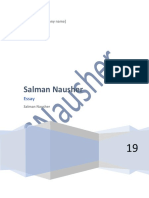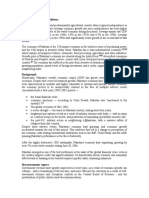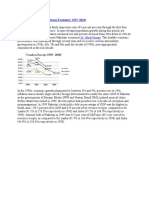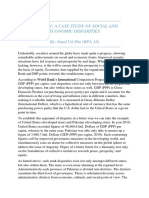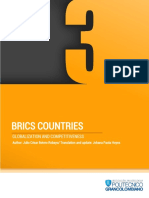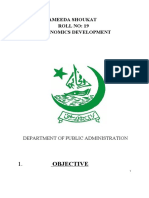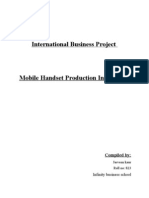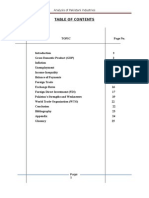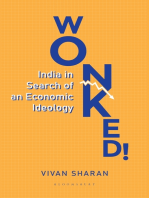July10 Libre
July10 Libre
Uploaded by
Hafni Zuhairi Mat HusinCopyright:
Available Formats
July10 Libre
July10 Libre
Uploaded by
Hafni Zuhairi Mat HusinOriginal Description:
Copyright
Available Formats
Share this document
Did you find this document useful?
Is this content inappropriate?
Copyright:
Available Formats
July10 Libre
July10 Libre
Uploaded by
Hafni Zuhairi Mat HusinCopyright:
Available Formats
ijcrb.webs.
com
INTERDISCIPLINARY JOURNAL OF CONTEMPORARY RESEARCH IN BUSINESS
ECONOMIC DEVELOPMENT: A COMPARATIVE STUDY ON
PAKISTAN AND BANGALDESH
Akmal Shahzad
MS Scholar, Iqra University H-9, Islamabad.Pakistan
everbrighter2011@gmail.com
Dr. Bashir Ahmed Khilji Professor &
Head of Economic Department. National
University of Modern Languages Sector H-
9, Islamabad
Irfan Ahmed
MS Scholar, Iqra University H-9, Islamabad.Pakistan
Abstract
JULY 2010
VOL 2, N O 3
Listed in ULRICH S
This paper discussed economic development in Pakistan and Bangladesh. It is a
comparative study, which try to explore causes and variable involves in creating
difference in both country development. A descriptive method employed in this regards.
This study considers the Democracy, rule of law & governance; Human index, and
Economy structure in this regard. Data range from 1980 to 2009. The data range was
selected on base of availability of data. Our result reveals better trend in Bangladesh than
Pakistan.
Keywords: Economic Development, Comparative Study , Pakistan , Bangaldesh
1. Introduction
Asian countries are dominating the world economy after structural reforms. Asia shows
strong growth till the currency crises. Some expert think, Asia will be the new centre of
economic gravity as most of Asian stand in middle or upper class income country. Most
of the Asian country especially South Asian Courtiers are agrarian. Empirical literature
support argument that Agricultural sector plays a major role in economic growth. Other
COPY RIGHT 2010 Institute of Interdisciplinary Business Research
249
ijcrb.webs.com
INTERDISCIPLINARY JOURNAL OF CONTEMPORARY RESEARCH IN BUSINESS
JULY 2010
VOL 2, N O 3
than Asian tiger, S4 countries (India, Pakistan, Bangladesh, Bhutan), emerging economy,
has shown prominent growth in GDP before world economic crises 2007-2009.
Subcontinent countries are rich of natural resources. Almost all subcontinent countries
gets freedom after fall of British Empire 60 years ago except Nepal, Afghanistan and
Bhutan. Despite such similarity some country growing faster than other and more
fluctuation as figure no. 1 shows. This study explores the reason why?
Fig No. 1 GDP GROWTH RATE OF SUBCONTINENT COUTNRIES 1969-2009
Source: World Bank World Development Indicators
After abolish of British rule, Pakistan emerged as separate country under two-nation
theory and East Bengal (East Pakistan) joined Punjab, Sind, NWFP and Baluchistan
(West Wing) in 1947. Both have common history, different culture, different language
and different climate. Distance between two wings about 1500 miles. East Pakistan
becomes Bangladesh, an independent country, after civil war 1971. Economy of West
Pakistan (Pakistan) and East Pakistan (Bangladesh) deteriorated in civil war. No doubt
infrastructure of Bangladesh more badly affect than Pakistan but this also creates panic
for Pakistan economy. In 1971 Pakistan had a GDP per capita about US Dollar 17.22 and
Bangladesh had a GDP per capita about US Dollar 17.23 (world Economic Indicator).
In 2008, Pakistan had slightly higher GDP per capita of $ 2600 than Bangladesh s GDP
per capita $ 1500. Bangladesh ranked 164 with 47.5% literacy rate and Pakistan got
position 160 with literacy rate 49.2% in 2009 world literacy ranking. Infant mortality rate
in Pakistan is 65.14 deaths/1,000 live births, while Bangladesh has infant mortality rate
59.02 deaths/1,000 live births. Both countries have shifted their economy from
agricultural base to service base which contributes 53% to GDP. Agricultural sector
COPY RIGHT 2010 Institute of Interdisciplinary Business Research
250
ijcrb.webs.com
INTERDISCIPLINARY JOURNAL OF CONTEMPORARY RESEARCH IN BUSINESS
JULY 2010
VOL 2, N O 3
contributes almost with same ratio (19.6%, 19%) to gross domestic output in Pakistan
and Bangladesh. For more comparison, table 1 listed below.
Fig No. 2 GDP growth of Pakistan and Bangladesh 1969 2009
Source: World Bank World Development Indicators
Table 1: Comparison Static
PAKISTA
N
BANGLADES
H
Population (Millions) 2009 17 15
Population below the NPL (%) 24 45
Debt Service commitment (2008) 1.1% 1.8%
Number of Domestic companies (2009) 584 411
FDI in US$ Billion (2009) 3.2 0.941
Exports (Billions) 22 14
Import (Billions) 38 20
CPI inflation rate (2009) 20.3% 8.9%
Foreign Exchange Reserve(Billion)US$ 10.48 0.61
HDI 0.572 0.543
Gini coefficient 30.6 33.4
Source: Economic Review of Pakistan, Economic Review of Bangladesh
Pakistan and Bangladesh have same historical background and face similar situations.
Both are Islamic state and enriched with natural resources. There is little bit difference in
climate and Bangladesh often hit by cyclone. Despite all this the trend of economic
growth shows Pakistan Economy is more instable as compare to Bangladesh. Bangladesh
shows consistency in growth rate after structural reforms since 1990. According to World
Bank report 2005-06, Bangladesh has gain 10
th
position among the 31 fast developing
countries. No doubt, in Pakistan number of reforms program promulgates in past. Such
COPY RIGHT 2010 Institute of Interdisciplinary Business Research
251
ijcrb.webs.com
INTERDISCIPLINARY JOURNAL OF CONTEMPORARY RESEARCH IN BUSINESS
JULY 2010
VOL 2, N O 3
programs are not as much effective as in Bangladesh which depict from volatility in
Pakistan economic growth. Corruption, weak institution, lack of infrastructure, Low
saving rate etc are common obstacle to both countries economy. This study tries to
explain the divergence in development by analyzing some natural and artificial difference
among Pakistan and Bangladesh considering various factors.
2. Factor contribute to Difference in Economic Development
2.1 Democracy, Governance, and Rule of Law
Since birth, Both Pakistan and Bangladesh has faced the similar situation. Political
situation is not good. Military establishment is more powerful and derail the democratic
process. Week Political institution, lack of accountability, bureaucratic control, and
feudalism are also major contributor toward instability of democratic process. Despite all
these similarity Bangladesh shows more stability toward political stability as compared to
Pakistan.
Figure No. 3 Political Rights Index 1972 - 2007
Source: House of Freedom
Bangladesh is less diverse in linguistic, culture and ethnicity groups as compared to
Pakistan. Moreover Bangladesh has no or minor boundary conflict, provincialism,
linguistic problem, terrorist activity and ethnicity groups activity. In Pakistan, conflict
among province exists over resources and revenue distribution. Numbers of issue are still
COPY RIGHT 2010 Institute of Interdisciplinary Business Research
252
ijcrb.webs.com
INTERDISCIPLINARY JOURNAL OF CONTEMPORARY RESEARCH IN BUSINESS
JULY 2010
VOL 2, N O 3
to address among the state and province, among the provinces and within provinces
territory. As compare to Pakistan, Bangladesh has uniformity in culture and population.
There are 90% Bengali speaking and 85% are Muslim. The only social threat by the
Bihari, the people describe themselves as stranded Pakistani, live misery condition in
camps. In 1999 Bangladeshi govt has successfully accord with Parbattya Chattagram
Janasanghati Samitti and closed an era of conflict.
Figure No. 4 Rule of Law
Source: World Economic Indicator
In short Pakistan is heterogeneous state as compare to Bangladesh. Due to heterogeneity,
each ethnic leader has its own priority; Censuses on national issue is hardly observed.
Figure No. 5 Govt Effectiveness
Source: World Economic Indicator
COPY RIGHT 2010 Institute of Interdisciplinary Business Research
253
ijcrb.webs.com
INTERDISCIPLINARY JOURNAL OF CONTEMPORARY RESEARCH IN BUSINESS
JULY 2010
VOL 2, N O 3
2,2 Investment and Human Development
Basic principle of economics is that the economic growth required capital investment.
Literature on investment also reveals that domestic investment is key determinant of the
capital / labor ration and economic growth. Figure No. 5 indicate that Pakistan invested
18.6% of GDP in machinery and equipment on average from 1975 to 2008 as compared
to 18.3% of GDP in Bangladesh.
Figure No. 6 Gross Capital Formation 1975 2008 (% of GDP)
Source: World Bank, World Development Indicator 2008
People are the real asset of the country. Therefore effort to promote socioeconomic
programs should encourage. Literature on Human development depicts that Human
development and economic growth are correlated. Human capital is more valuable than
commodities and financial wealth. Human development is vital role to the economic
development of a country [UNDP Report 1994). Human development computes on three
dimensions i.e. education, health and income. Education and Health has vital role in
development of human capital. Education sector, in developing countries, has influential
role in industrial development. Education is a source of skilled and productive manpower.
Education is a wealth distribution vehicle as it helps poor to grasp the opportunity
provided by economic growth. More education increases the learning desire and reduces
the fertility.
COPY RIGHT 2010 Institute of Interdisciplinary Business Research
254
ijcrb.webs.com
INTERDISCIPLINARY JOURNAL OF CONTEMPORARY RESEARCH IN BUSINESS
JULY 2010
VOL 2, N O 3
Up to separation there is great disparity exist in education sector among Pakistan and
Bangladesh. Bangladesh is far behind Pakistan, Asadullah (2004). Bangladeshi Govt
committed itself to implement reforms in education sector and launched number of
projects from universal primary education, Food for education and Education for All
(EFA) program [BMoPME]. Samer Al-Samarrai (2007) higlighted the increase in
education budget more as compared to 2000. It is fruit of committed policy that gross
primary enrollment rate (Male & Female) reached to 90% in 2007[BSTD]. Her Education
sector flourished dramatically late 1990. NGO s, uniform culture, 90% Bengali speaking
and small area, which easy to administrate, has key role to promote primary education in
Bangladesh, [BMWCA Report].
In contrary to Bangladesh, Pakistan is more diverse in culture and linguistic. Pakistani
Govt is committed to free education for all. Early decade observed slow rate despite
number of reasons, one of them is lack of teaching staff described by Behrman (1976).
After denationalization policy, private sector has played vital role. Private sector shares
much burden of Govt expenditure on this sector as described by Andrabi et al (2002).
Gross primary enrollment rate (Male & Female) in Pakistan is 92% [World Bank-2007]
Figure No.7 Primary School Enrollment in Million (1980 2006)
Source: Nattion Master &Statisticl Bureau Pakistan & Bangladesh
In 2007, nearly 33 % of youngsters of Pakistan attend secondary schools compared with
43% of Bangladesh. The ratio attending the college and university is 7.2% in Bangladesh
where as in Pakistan 5.1%. Education expenditure in Pakistan is 2.9% of GDP where as
in Bangladesh 2.4% of GDP. In last budget Bangladesh allocate 7.7 Billion (US Dollar)
where as Pakistan allocate 3.4 Billion (US Dollar).
COPY RIGHT 2010 Institute of Interdisciplinary Business Research
255
ijcrb.webs.com
INTERDISCIPLINARY JOURNAL OF CONTEMPORARY RESEARCH IN BUSINESS
JULY 2010
VOL 2, N O 3
Other element of human capital that helps to uphold the economic development of a
country is the health of its labor force and general population. Life expectancy rate (at
birth) for female in Bangladesh rise from 54% in 1990 to 64% in 2007 and for male it is
54% to 63%. Whereas in Pakistan for female it jumps from 59% to 64% and for male it is
58% to 63% during the same period. Bangladesh health expenditure fall 3.4% to 3.2% of
GDP from 2002 to 2006 while Pakistan health expense fall 2.3% to 2.00% of GDP.
Redman et al (2007) stated more struggle is still required to improve literate life
expectancy in rural area. Akram and khan (2007) described inequality in health service in
Pakistan. Under the slogan water for all Bangladesh govt has take stern action and 75%
Bangladesh has access to improved drinking water system. In Pakistan there is only 18%
population which has access to clean water.
Figure No. 8 Human Development Index
Source: World Bank, World Economic Indicator
2. 3 Export, Inflation and Economy Structure
Bangladesh has been a little bit more open than Pakistan. Freedom to trade index of
Pakistan has changed from 4.09 (1980) to 5.83 (2007) where as Bangladesh index has
changed from 2.24 (1980) to 5.94 (2007). Pakistan is more restrictive to import as 7.14%
tax revenue from trade sector while in Bangladesh revenue from trade sector is 5.89%
(EFW-2009).
Figure No. 9 Export of Goods and Services 1998 to 2008(% of GDP)
COPY RIGHT 2010 Institute of Interdisciplinary Business Research
256
ijcrb.webs.com
INTERDISCIPLINARY JOURNAL OF CONTEMPORARY RESEARCH IN BUSINESS
JULY 2010
VOL 2, N O 3
Source: Annual Report Economic Freedom of World
Stability in Price is a good sign for economic growth. Figure 9 below reveals that
Bangladesh manage to bring inflation down almost as far Pakistan in 1988. In 1990s
inflation in Bangladesh remain below the Pakistan. After 2000, rising trend observed both
countries.
Figure No. 10 Inflation rate 1980 2008
Source: World Bank Economic Indicator
In 2008, inflation in Pakistan is higher than Bangladesh as the result of monetary and
other problems. Therefore, it is not surprising that the process of monetization is in down
ward in Pakistan than in Bangladesh. High inflation leans to hold back economic growth
by various channels. Inflation may reduce financial depth or by daunting the financials
capital accumulation, deprive the financial lubrication which impedes economic
efficiency and growth.
Figure No. 11 Financial Depth 2005 to 2008 (M2 % OF GDP)
COPY RIGHT 2010 Institute of Interdisciplinary Business Research
257
ijcrb.webs.com
INTERDISCIPLINARY JOURNAL OF CONTEMPORARY RESEARCH IN BUSINESS
JULY 2010
VOL 2, N O 3
Source: World Economic Indicator
Exchange rate has its own role in economic growth. Levy and Sturzenegger (2003)
argued that Peg exchange rate cause less inflation and less economic growth as compared
to flexible rate. Gosh et al (2000) supported the peg rate. Their result showed that country
with hard pegs had less inflation and high growth rate. Since separation, both countries
adopted pegged exchange rate. Figure 2 showed that Bangladesh showed more
sustainable growth since 1990 as compared to Pakistan and have low inflation figure 10.
Both the countries are agrarian. Bangladesh reduced its agricultural share since 1990
from 40% to 22% in 2008 where as Pakistan sustained the share at 20%.
Figure No. 12 Agriculture 1990 2008 (% of GDP)
Source: World Economic Indicator
Bangladesh and Pakistan have large natural reservoir and human manpower. Both
endeavor to modernize it economy. Manufacturing sector in Bangladesh is more rapid
due to boom in knit wear industry as compared to Pakistan. The manufactured sector is a
key factor to economic growth as it encourages research and technological progress far
beyond the agriculture and builds up human capital as well.
COPY RIGHT 2010 Institute of Interdisciplinary Business Research
258
ijcrb.webs.com
INTERDISCIPLINARY JOURNAL OF CONTEMPORARY RESEARCH IN BUSINESS
Fig No. 13 Manufacturing Sector (% of GDP)
JULY 2010
VOL 2, N O 3
As for Business start up, it took 44 days to start a business in Bangladesh against 20 days
in Pakistan (DBR-2010). Pakistan ranked at 117 where as Bangladesh placed at 137. If
the improvement in ease of doing business sustained, investment could rise and country
could also rise. To summarize, economic growth requires capital to be accumulate and to
be efficiently.
Figure No. 14 Economic Freedom Index 1995 2010
Source: Heritage Foundation
3. Conclusion
The different economic development of Pakistan and Bangladesh since separation
suggests policy implication. Bangladesh shows sustainable growth rate since 1990. On
other hand Pakistan has more fluctuating history of GDP rate. Previous section discussion
reveals that Pakistan and Bangladesh moving side by side in all indicator which discussed
then why Bangladesh ahead than Pakistan and show sustain growth rate.
COPY RIGHT 2010 Institute of Interdisciplinary Business Research
259
ijcrb.webs.com
INTERDISCIPLINARY JOURNAL OF CONTEMPORARY RESEARCH IN BUSINESS
JULY 2010
VOL 2, N O 3
The sustain growth of Bangladesh attributes to its consistence policy toward trade
openness, education, Political stability and investment friendly business environments.
Bangladesh receiving foreign aid unconditionally and there is no Taliban like threat. In
Bangladesh rule of law and Govt effectiveness is improving. Policy maker prudently use
the resources and manage to lower the cost of factor of production. They also curtailed
the inflation.
Major threat to Pakistan economy is Taliban and ethnicity group. State institutions and
political system is not strong enough. Corruption, terrorism and foreign intervention in
policy decision create uncertainty and investor reluctant to invest. These entire factors
contribute to worst Pakistan economy.
COPY RIGHT 2010 Institute of Interdisciplinary Business Research
260
ijcrb.webs.com
INTERDISCIPLINARY JOURNAL OF CONTEMPORARY RESEARCH IN BUSINESS
References
JULY 2010
VOL 2, N O 3
Ali, S & Tahir S.A Malik (2009), Reforming Education in Pakistan: Tracing Globle
Links,:Journal of Research and Reflections in Education
Abbas, Q & Peck, J.F (2007), Human Capital and Economic Growth: Pakistan, 1960-2003 NRPU
projects by Higher Education Commission (HEC) of Pakistan.
Asadullah, M. N. (2004). Educational Disparity in Pakistan 1947 -71. UK Economic and
Social History Conference.
Asia Development Bank, Regions & countries (n,d), Retrieved from http://www.adb.org
Gosh et al (2000). Currency Boards: More than a Quick Fix? Economic Policy . 15, 269 -
335.
Govt of Bangladesh, Economic Survey of Bangladesh.(n,d), Retrieved from
www.mof.gov.bd
Govt of Pakistan, Paksitan Economic Survey (n,d), Retrieved from www.Finance.gov.pk
Kronstadt, K. Alan (2004), Education Reforms in Pakistan: Report of CRS for Congress
Samer Al-Samarrai (2007). Financing Basic Education in Bangladesh , University of Sussex,
Falmer, Brighton United Kingdom
Sidduqi, R & Kemal, A.R (2006), Remittances, Trade Liberalization, and Poverty in Pakistan:
The Role of Excluded Variables in Poverty Change Analysis, PIDE Working Paper.
The National Bureau of Asian Research, Data (n.d.). Retrieved from
http://strategicasia.nbr.org
World Bank, Country & Regions (n,d),Reterived from, http://worldbank.org
COPY RIGHT 2010 Institute of Interdisciplinary Business Research
261
ijcrb.webs.com
INTERDISCIPLINARY JOURNAL OF CONTEMPORARY RESEARCH IN BUSINESS
Govt of Bangladesh, http://www.moedu.gov.bd
Govt of Bangladesh, http://www.mowca.gov.bd
Govt of Bangaldesh, www.bbs.gov.bd
Govt of Pakistan, www.moe.gov.pk.
State Bank of Pakistan, www.statpak.gov.pk
www.economywatch.com
www.nationmaster.com:
www.bangladesh-bank.org
www.doingbusiness.org
www.Freedomhouse.Com
www.heritage.org/index
JULY 2010
VOL 2, N O 3
COPY RIGHT 2010 Institute of Interdisciplinary Business Research
262
You might also like
- Economic Problems of Pakistan and SolutionsDocument8 pagesEconomic Problems of Pakistan and SolutionsYousuf Zahid73% (15)
- Alternative to the Imf: And Other out of the Box SolutionsFrom EverandAlternative to the Imf: And Other out of the Box SolutionsRating: 4 out of 5 stars4/5 (2)
- Bangladesh Pest AnalysisDocument5 pagesBangladesh Pest AnalysisMonirul Islam MoniirrNo ratings yet
- Case Study 2Document11 pagesCase Study 2Cheryl RamosNo ratings yet
- Introduction To The Financial Sector of PakistanDocument26 pagesIntroduction To The Financial Sector of PakistanmeharahutshamNo ratings yet
- Bhutan Development ReportDocument13 pagesBhutan Development Reportdasraktima2006No ratings yet
- Seema 22181 Pep Assignment 8Document21 pagesSeema 22181 Pep Assignment 8Seema KhanNo ratings yet
- Article On Pakistan Economy: Taruj TariqDocument29 pagesArticle On Pakistan Economy: Taruj TariqTeeJyy0% (1)
- Name: ID: Course: Business Economics 2. Course Instructor: ProfDocument3 pagesName: ID: Course: Business Economics 2. Course Instructor: ProfAbidiNo ratings yet
- Comparitive Economic Development: The 2020 GNI Per Capita Thresholds AreDocument8 pagesComparitive Economic Development: The 2020 GNI Per Capita Thresholds AreAmber KhanNo ratings yet
- DocumenttDocument17 pagesDocumenttHome Cuisine With RaheelaNo ratings yet
- Independent University Bangadesh: Assignment: Summer 2021Document11 pagesIndependent University Bangadesh: Assignment: Summer 2021Wasifa TahsinNo ratings yet
- ECN202 Ass Monira Sultana Kheya18211802 2Document11 pagesECN202 Ass Monira Sultana Kheya18211802 2Wasifa TahsinNo ratings yet
- Current Issues and Problems of PakistanDocument24 pagesCurrent Issues and Problems of PakistanAlifiya AunaliNo ratings yet
- GDP of Pakistan in Comparison To Other CountriesDocument3 pagesGDP of Pakistan in Comparison To Other CountriesImad Ud DinNo ratings yet
- Social Problems of BangladeshDocument10 pagesSocial Problems of BangladeshYousuf JamilNo ratings yet
- Economic Crisis in PakistanDocument6 pagesEconomic Crisis in PakistanSalman NausherNo ratings yet
- Executive SummaryDocument1 pageExecutive Summaryknight RiderNo ratings yet
- Economy of BangladeshDocument32 pagesEconomy of BangladeshMamun BappyNo ratings yet
- MPRA Paper 71473Document29 pagesMPRA Paper 71473JohnNo ratings yet
- Pakistan's Economy: Challenges and OpportunitiesDocument2 pagesPakistan's Economy: Challenges and OpportunitiesFarhan SarwarNo ratings yet
- DRDocument16 pagesDRmabdullah_asad9813No ratings yet
- Summary of BIPSS Dinner Discussion Club On Bangladesh Economic Outlook 2020Document2 pagesSummary of BIPSS Dinner Discussion Club On Bangladesh Economic Outlook 2020Anisur RahmanNo ratings yet
- GDP of PakistanDocument18 pagesGDP of PakistanFaizan HussainNo ratings yet
- Economy Overview of PakistanDocument4 pagesEconomy Overview of PakistanIbrahim MehkriNo ratings yet
- A Brief History of Pakistani Economy 1947Document15 pagesA Brief History of Pakistani Economy 1947Muhammad FarhanNo ratings yet
- Comparative Study of ParliamentaryDocument10 pagesComparative Study of Parliamentaryjamshaid perharNo ratings yet
- Book Review DRDocument3 pagesBook Review DRHaji Suleman AliNo ratings yet
- State of Microfinance in BhutanDocument45 pagesState of Microfinance in BhutanasianingenevaNo ratings yet
- Economic and Social Disparities in PakistanDocument3 pagesEconomic and Social Disparities in PakistanImad Ud DinNo ratings yet
- Economy of Pakistan - 240803 - 214050Document33 pagesEconomy of Pakistan - 240803 - 214050Workaholic.No ratings yet
- Development EconomicsDocument5 pagesDevelopment EconomicsvvarshakhetpalNo ratings yet
- Pakistan Studies NotesDocument25 pagesPakistan Studies NotesHadia Batool -TiktokfunsNo ratings yet
- Brics Countries: Globalization and CompetitivenessDocument12 pagesBrics Countries: Globalization and CompetitivenessAlejandroPachecoNo ratings yet
- Economic Zoology NotesDocument173 pagesEconomic Zoology NotesVarisha AhmedNo ratings yet
- Essay On How To Deal With Economic Woes of Pakistan PDFDocument6 pagesEssay On How To Deal With Economic Woes of Pakistan PDFsalmanyz6No ratings yet
- Instability & Its Impact On EconomyDocument6 pagesInstability & Its Impact On Economyrubaa ranaNo ratings yet
- Research Project EssayDocument6 pagesResearch Project Essayjack-singhNo ratings yet
- Rostow's Five Stages of DevelopmentDocument14 pagesRostow's Five Stages of DevelopmentHameeda ShoukatNo ratings yet
- Fifty Years of Bangladesh: Achievement in Population SectorDocument6 pagesFifty Years of Bangladesh: Achievement in Population SectorInternational Journal of Business Marketing and ManagementNo ratings yet
- Comparison Between The Economies of Pakistan and India: Submitted byDocument20 pagesComparison Between The Economies of Pakistan and India: Submitted byscholastictutoringNo ratings yet
- ECO303 Research Paper 1Document24 pagesECO303 Research Paper 1Mahi SinthiaNo ratings yet
- Economic Problems and Solutions For PakistanDocument9 pagesEconomic Problems and Solutions For Pakistana1306rishaNo ratings yet
- International Business Project: (Type Text)Document23 pagesInternational Business Project: (Type Text)Jasveen KaurNo ratings yet
- Economy of Pakistan CssDocument7 pagesEconomy of Pakistan CssAnsharah AhmedNo ratings yet
- Population Growth and Economic Development in Pakistan: Mohammad AfzalDocument7 pagesPopulation Growth and Economic Development in Pakistan: Mohammad AfzalChan MehboobNo ratings yet
- Revisiting The Potential Security Threats Linked With The China Pakistan Economic Corridor CPECDocument18 pagesRevisiting The Potential Security Threats Linked With The China Pakistan Economic Corridor CPEChafiza arishaNo ratings yet
- Economy: Economic Crises in PakistanDocument9 pagesEconomy: Economic Crises in PakistanTalha AsifNo ratings yet
- Pakistan VaDocument7 pagesPakistan VaYash MittalNo ratings yet
- Thesis On Economic Growth in PakistanDocument4 pagesThesis On Economic Growth in Pakistankristinreyeslasvegas100% (2)
- Economy Essay CssDocument8 pagesEconomy Essay CssZujajah GullNo ratings yet
- Trade - Balance of Trade in Paksitan, Effect of Primary and Tertiery Industry On Environemnt and Economic StabilityDocument6 pagesTrade - Balance of Trade in Paksitan, Effect of Primary and Tertiery Industry On Environemnt and Economic Stabilityfatima vaqasNo ratings yet
- PST FinalDocument36 pagesPST Finalrehansmall69No ratings yet
- Population Policy PakistanDocument26 pagesPopulation Policy PakistanMuhammad AlamNo ratings yet
- Economic History of PakistanDocument27 pagesEconomic History of PakistanGulraiz Hanif100% (21)
- Pakistan Problems, Solutions: To Recognize Pakistan's Main Problems and Propose Possible SolutionsFrom EverandPakistan Problems, Solutions: To Recognize Pakistan's Main Problems and Propose Possible SolutionsNo ratings yet
















